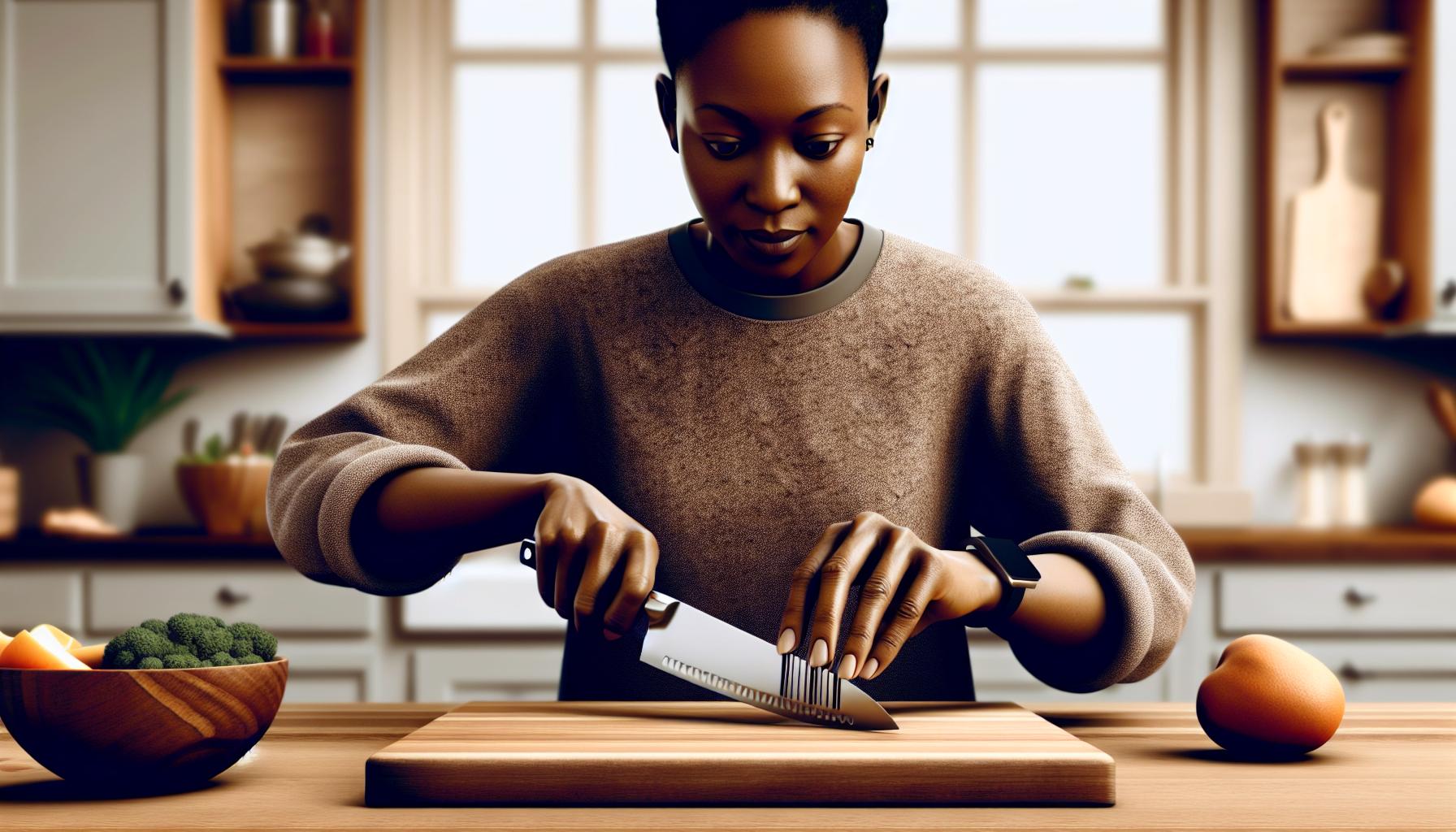The Best Fluffy Pancakes recipe you will fall in love with. Full of tips and tricks to help you make the best pancakes.
Mastering knife skills transforms ordinary home cooks into kitchen ninjas. Whether you’re dicing onions like a pro or creating paper-thin vegetable slices that would make a chef proud it all starts with proper knife techniques. These fundamental skills not only make cooking more efficient but also safer and more enjoyable.
From the precise chiffonade of fresh herbs to the perfect brunoise of carrots proper knife techniques elevate every dish. While it might seem daunting at first learning these essential skills isn’t rocket science. With the right guidance and practice anyone can develop the confidence to tackle any cutting task in the kitchen. Plus there’s something incredibly satisfying about hearing that rhythmic chop-chop-chop as the blade glides through ingredients with professional precision.
Understanding Kitchen Knife Anatomy and Types
Professional chefs rely on proper knife selection and understanding to execute precise cuts. Kitchen knives combine specific elements that enhance performance while serving distinct culinary purposes.
Essential Parts of a Kitchen Knife
A chef’s knife consists of five key components that work together to create an effective cutting tool. The blade extends from tip to heel, featuring a cutting edge for slicing and a spine for stability. The bolster connects the blade to the handle, providing balance and preventing fingers from slipping. The tang runs through the handle’s core, offering strength and durability. The handle incorporates ergonomic design elements with secure rivets for comfortable gripping during extended use.
- Chef’s knife (8-10 inches): Handles chopping vegetables mincing herbs slicing meats
- Paring knife (3-4 inches): Peels fruits deveins shrimp performs intricate cuts
- Bread knife (8-10 inches): Slices crusty breads cakes delicate pastries
- Santoku knife (5-7 inches): Dices vegetables chops fish creates thin slices
- Utility knife (4-7 inches): Cuts sandwiches trims fat portions small items
- Boning knife (5-6 inches): Removes bones separates joints breaks down poultry
| Knife Type | Length (inches) | Primary Uses |
|---|---|---|
| Chef’s | 8-10 | All-purpose cutting |
| Paring | 3-4 | Precise detail work |
| Bread | 8-10 | Serrated cutting |
| Santoku | 5-7 | Asian-style chopping |
| Utility | 4-7 | Small task cutting |
| Boning | 5-6 | Meat preparation |
Basic Knife Grip and Posture

Proper knife handling starts with mastering the fundamental grip and body position. A secure grip combined with correct posture forms the foundation for safe and efficient cutting techniques.
Proper Hand Positioning
The dominant hand grips the knife handle using a “pinch grip” technique. The thumb and index finger grasp the blade near the handle’s bolster while the remaining three fingers wrap around the handle. This grip maximizes control and precision during cutting tasks. The non-dominant hand forms a “claw grip” with fingers curled inward and knuckles facing the blade. The thumb tucks behind the fingers to create a stable platform for guiding the knife while protecting fingertips from cuts.
Maintaining Stability While Cutting
A stable stance begins with positioning feet shoulder-width apart with toes pointing forward. The cutting board sits at elbow height with the body positioned square to the work surface. The shoulders remain relaxed with elbows tucked close to the body. The wrist of the knife hand stays straight and aligned with the forearm to prevent fatigue. The non-dominant hand holds ingredients firmly against the cutting board using the claw grip technique for enhanced control during slicing motions.
Fundamental Cutting Techniques
Professional chefs employ specific cutting techniques to achieve consistency in food preparation. Each method serves distinct purposes in creating uniform pieces that cook evenly.
The Slice and Push Cut
The slice cut creates clean cuts through ingredients using a fluid forward motion. Placing the knife tip on the cutting board anchors the blade while the heel moves forward through ingredients in a single stroke. The push cut involves pressing straight down with the blade to make precise cuts, particularly effective for vegetables like carrots celery onions. Expert chefs maintain a 20-degree angle between the knife blade and cutting surface during both techniques for optimal control.
Rock Chopping Method
Rock chopping utilizes the curved belly of a chef’s knife to create a rhythmic cutting motion. The knife tip stays in contact with the cutting board while the blade rocks back and forth through ingredients. This technique excels at processing herbs leafy greens garlic into fine pieces quickly. Professional kitchens rely on rock chopping to maintain efficiency during high-volume food preparation.
Cross Chop and Mince
Cross chopping creates ultra-fine cuts by making perpendicular passes over ingredients. The technique starts with parallel cuts followed by cuts at 90-degree angles to produce uniform pieces. Mincing builds on cross chopping by gathering ingredients into a tight pile repeating the cross-cut pattern 3-4 times. These methods transform herbs aromatics vegetables into tiny uniform pieces measuring 1/8 inch or smaller for consistent cooking results.
Common Knife Cuts for Vegetables
Professional chefs use specific knife cuts to create uniform pieces that cook evenly and enhance dish presentation. Each cut requires precise measurements and consistent technique to achieve optimal results.
Julienne and Batonnet
Julienne cuts create thin matchstick-shaped strips measuring 1/8 inch × 1/8 inch × 2-3 inches. Batonnet cuts produce slightly thicker strips at 1/4 inch × 1/4 inch × 2-3 inches. These cuts start by squaring off the vegetable into a rectangular block, slicing it lengthwise into planks, cutting these planks into strips, then cutting across to achieve the desired length. Common vegetables for these cuts include carrots, celery, peppers zucchini.
Dice and Brunoise
Dice cuts come in three sizes: large (3/4 inch), medium (1/2 inch) small (1/4 inch). Brunoise represents the smallest cube cut at 1/8 inch, created by reducing julienne strips into tiny squares. Making uniform dice cuts begins with squaring off vegetables into rectangular shapes, then cutting them into equal-sized cubes. Onions, potatoes, carrots tomatoes respond well to these cutting techniques.
Chiffonade Technique
Chiffonade produces delicate ribbons of leafy vegetables herbs. This technique involves stacking leaves, rolling them tightly into a cigar shape, then slicing across the roll to create thin strips. The ideal width for chiffonade cuts ranges from 1/16 to 1/8 inch. Basil, mint, spinach lettuce transform into elegant garnishes decorative elements through this method. Chefs apply this cut to create visually appealing salads garnishes.
Specialized Cutting Skills
Professional chefs master specialized cutting techniques to handle proteins efficiently. These advanced skills reduce waste while maximizing yield from expensive ingredients.
Breaking Down Poultry
Breaking down poultry starts with locating key anatomical joints. The process begins by removing the legs at the hip socket using firm pressure to snap the joint. Sharp cuts separate breast meat from the ribcage by following natural seams between muscles. Professional butchers remove wings at the shoulder joint with a single precise cut. Experienced cooks create eight uniform pieces from a whole chicken in under 3 minutes. French cutting techniques expose clean wing bones for elegant presentation. The separated parts include:
- Two breast portions with skin intact
- Two thigh-leg quarters
- Two wings with first joint removed
- Two tenderloins from inner breast
- One carcass for stock making
Filleting Fish
Filleting fish requires precise cuts along the backbone to maximize meat yield. The technique starts behind the gills with a sharp flexible knife angled slightly downward. Smooth strokes separate flesh from bones while maintaining constant contact with the skeleton. Professional chefs achieve 40% higher yield compared to amateur filleting. Key steps include:
- Removing scales with firm backward strokes
- Creating an initial cut behind the head
- Following the backbone from head to tail
- Lifting fillets while cutting connective tissue
- Removing pin bones with specialist pliers
- Trimming away belly fat membranes
- Positioning meat with the grain running horizontally
- Creating uniform slices with steady knife pressure
- Maintaining consistent thickness of 1/4 to 1/2 inch
- Separating muscle groups at natural seams
- Trimming excess fat bands between cuts
- Arranging slices to showcase internal doneness
Knife Maintenance and Safety
Professional knife care extends blade life, ensures consistent cutting performance and maintains safety in the kitchen. Regular maintenance prevents dulling, rust formation and potential accidents during food preparation.
Proper Cleaning and Storage
Knives require immediate cleaning after each use with warm water and mild dish soap. Hand-drying prevents water spots and rust formation on the blade. Magnetic knife strips provide optimal storage by keeping blades separated and protected from damage. Wooden knife blocks serve as alternative storage solutions when placed away from heat sources and moisture. Professional kitchens use knife rolls or cases for safe transport and organization of multiple blades. Cross-contamination prevention requires thorough sanitization between different food types.
Knife Sharpening Basics
Professional chefs maintain blade sharpness using whetstones in specific grit sequences (1000-6000). Honing steels realign knife edges between sharpening sessions through 3-4 strokes on each side at a 20-degree angle. Electric sharpeners offer convenience for home cooks but remove more metal than manual methods. Ceramic sharpening rods work effectively on Japanese steel knives. Testing blade sharpness involves slicing through paper or checking if a tomato’s skin splits without pressure. Regular sharpening cycles vary based on usage frequency: professional kitchens sharpen weekly while home cooks typically need monthly maintenance.
Conclusion
Mastering knife techniques transforms everyday cooking into a professional culinary experience. With proper grip knives become natural extensions of the hand allowing for precise and efficient food preparation. The combination of the right tools proper technique and regular maintenance creates a foundation for culinary success.
Whether it’s basic vegetable cuts or advanced protein preparation these essential skills enhance both the cooking process and final presentation. As home cooks continue practicing these techniques they’ll find themselves working with increased confidence and achieving restaurant-quality results in their own kitchens.
The journey to mastering knife skills is ongoing but the rewards of faster prep times safer cooking practices and beautifully prepared ingredients make it well worth the effort.

